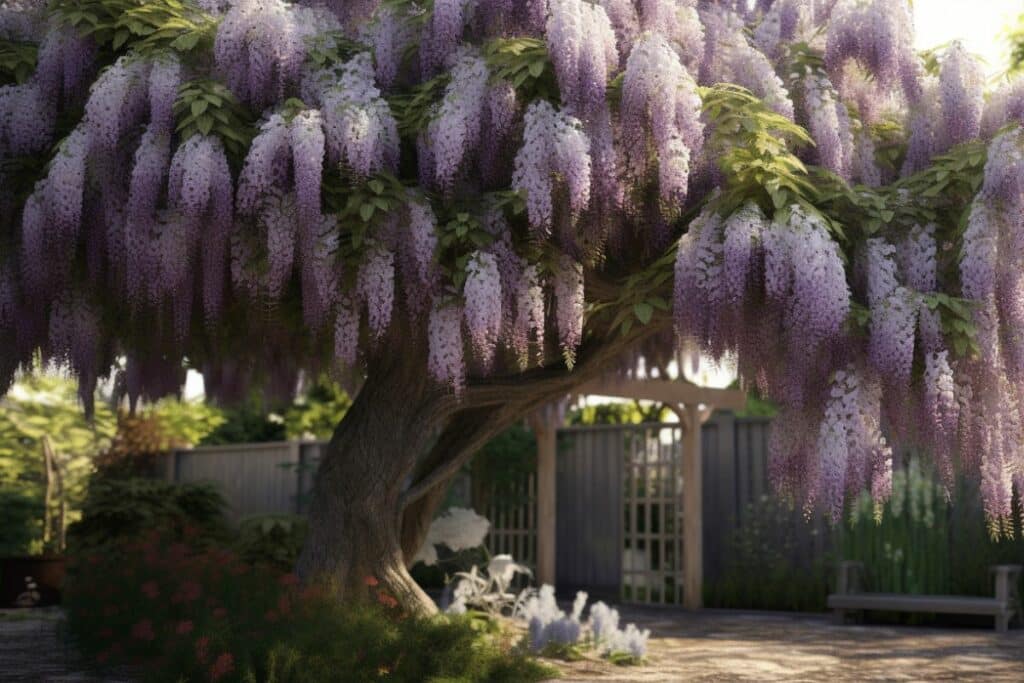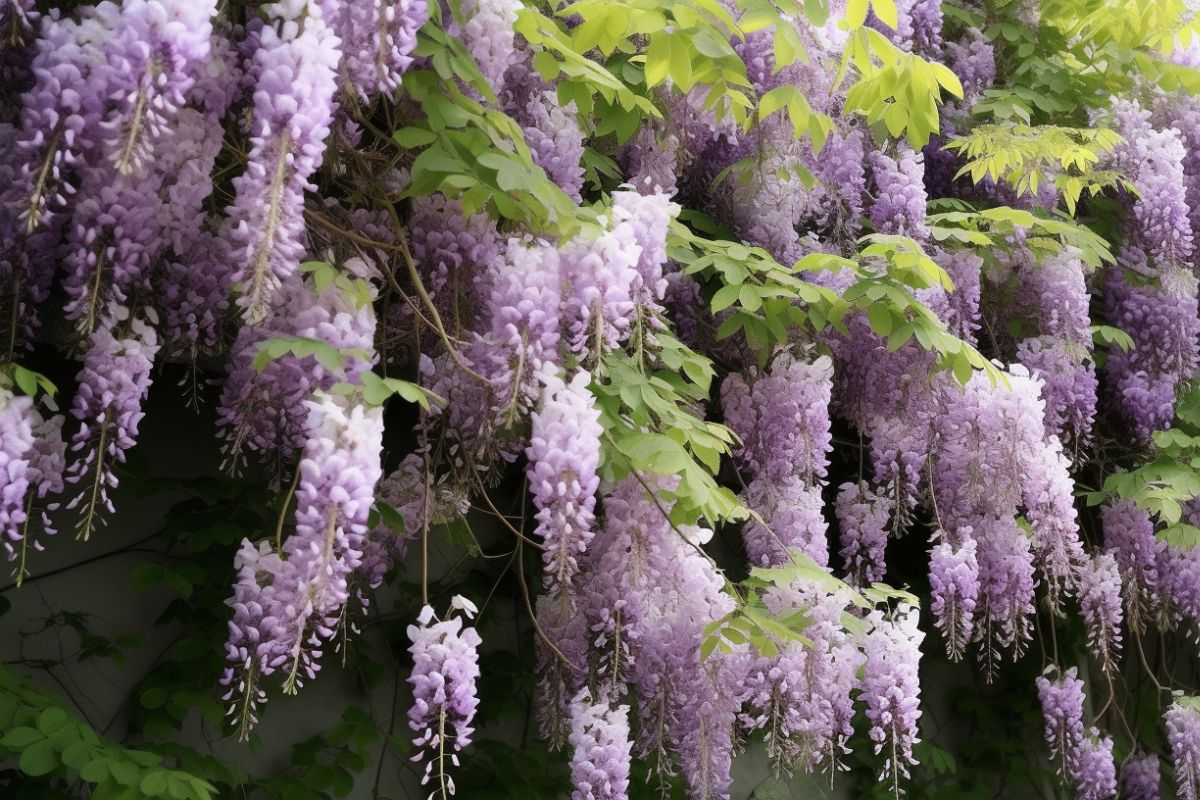As you delve into the enchanting world of Wisteria, a genus belonging to the Fabaceae family, you are presented with two captivating options: trees and vines.
Each flaunts its mesmerizing floral displays and boasts unique characteristics. It’s no wonder that these plants have captured the hearts of many horticulturists and garden enthusiasts alike.
This article will provide you with an in-depth analysis of these two distinct forms – Wisteria trees (trained standards) and Wisteria vines (climbing varieties), elucidating key differences, pros, and cons, as well as tips on selecting the perfect specimen for your verdant sanctuary.
Key Differences Between the Two Types

You’ll be amazed by the key differences between wisteria trees and vines, each showcasing their unique beauty in distinct ways.
One of the most striking contrasts lies in their climbing habits: while wisteria vines are known for their ability to twine around structures, such as trellises or pergolas, wisteria trees are more self-supporting due to sturdy trunks and branches.
Additionally, these two types exhibit different flowering patterns; wisteria vines produce long cascading racemes of flowers that can reach up to 3 feet in length, whereas the blooms on a wisteria tree tend to be shorter and more compact.
When it comes to maintaining these botanical specimens, pruning techniques differ significantly. Wisteria vines require regular pruning throughout the year for optimal flower production and controlled growth – typically involving the removal of unwanted lateral shoots and shortening of new growth.
In contrast, wisteria trees need less frequent pruning focused on shaping the canopy and removing any dead or damaged wood.
Another noteworthy distinction is found in their soil preferences: while both types thrive in well-draining soil with ample nutrients, wisteria trees generally prefer slightly acidic conditions compared to the more neutral pH favored by most vine varieties.
The beauty of these plants extends beyond their blossoms as they also display foliage variations that contribute to their individual allure.
Wisteria vines flaunt lush green leaves composed of multiple leaflets arranged symmetrically along a central stem – creating an attractive backdrop for their vibrant flowers.
On the other hand, wisteria trees possess larger leaves with fewer leaflets per stem but offer greater variation in coloration ranging from deep green hues to golden yellow shades depending on cultivar selections and growing conditions.
As you delve into understanding these magnificent plants further, you will undoubtedly uncover even more fascinating distinctions that make each type uniquely captivating in its own right.
Pros and Cons of Wisteria Trees

There’s no denying that having a wisteria tree can be both a blessing and a curse; its breathtaking beauty may steal your heart, but the extensive maintenance it requires could very well break your back.
The wisteria tree (Wisteria spp.) belongs to the Fabaceae family and is known for its stunning, cascading flowers create an almost ethereal atmosphere in any garden.
However, before you decide to plant one in your backyard, weighing the pros and cons of this captivating yet demanding species is essential.
- Tree maintenance: Wisteria trees are notorious for their vigorous growth habits and require regular pruning to keep them in check. This not only ensures optimal blooming patterns but also prevents potential damage caused by heavy branches.
- Blooming patterns: When properly maintained, wisteria trees boast impressive floral displays during spring, with some varieties even offering sporadic blooms throughout summer.
- Soil requirements: These trees thrive in well-draining soil with moderate fertility levels; however, they can tolerate various soil types as long as they don’t become waterlogged.
- Wildlife attraction: Wisterias are beloved by pollinators such as bees and butterflies, which contribute to maintaining a healthy ecosystem within your garden.
On the flip side, there are some concerns associated with owning a wisteria tree:
- Allergy concerns: Some people may experience allergies due to the pollen produced by these plants during their blooming season.
- Invasive nature: If left uncontrolled, wisterias can become invasive and overwhelm other plants in your garden or even cause structural damage if grown too close to buildings.
- High maintenance: As mentioned earlier, these trees demand significant time and effort for proper pruning practices that might not suit every gardener.
Taking all of these factors into account will help you make an informed decision about whether or not a wisteria tree is the right fit for your garden.
While it undoubtedly brings an enchanting beauty and charm, be prepared to dedicate time and effort to maintaining its health and growth.
If you’re up for the challenge, a wisteria tree can become a stunning focal point in your garden that will continue to captivate you with its mesmerizing blooms year after year.
Pros and Cons of Wisteria Vines

Imagine the enchanting sight of cascading flowers enveloping your garden’s pergola or trellis while you sit back and admire their beauty; that’s the allure of wisteria vines.
Wisteria vines are part of the Fabaceae family, known for their stunning floral displays in shades of purple, blue, pink, and white.
There are two primary species native to Asia – Wisteria floribunda (Japanese Wisteria) and Wisteria sinensis (Chinese Wisteria). These vigorous climbers require sturdy climbing support and can reach heights of over 30 feet with proper care.
One significant advantage of wisteria vines is their blossom abundance. They produce long racemes densely packed with fragrant flowers that attract pollinators like bees and butterflies.
To encourage optimal flowering on your vine, regular pruning techniques must be implemented – this consists of cutting back unwanted growth during summer months and shortening side branches during winter months.
Vine maintenance is essential as these plants have a rapid growth rate and can become unruly if left unchecked. However, there are some invasive concerns associated with wisteria vines due to their aggressive growth habit.
In some regions, they have been known to escape cultivation areas and invade natural habitats, which may negatively impact local ecosystems by outcompeting native vegetation for resources such as sunlight, nutrients, and water.
Here are trees with purple flowers that can be less maintenance.
This issue highlights the importance of responsible planting practices when introducing these plants into your garden landscape.
Despite these potential drawbacks, when managed correctly through regular pruning and monitoring for signs of spreading beyond designated areas, wisteria vines can make an impressive statement in any outdoor space while providing beauty throughout its blooming season.
Choosing the Right Wisteria for Your Garden

It’s a delightful dilemma, deciding between the captivating charm of climbing vines or the majestic allure of a standalone tree when selecting the perfect wisteria for your garden.
As you weigh your options, consider not only the aesthetic appeal but also the growth patterns, soil preferences, pruning techniques, blooming seasons, and pest resistance of each type.
By understanding these factors and how they align with your gardening goals and abilities, you can make an informed decision that will bring beauty and satisfaction to your outdoor space.
- Growth Patterns: Wisteria vines are known for their vigorous growth and ability to climb structures such as trellises, pergolas, or fences. They can reach heights of 20-30 feet (6-9 meters) and require sturdy support to prevent damage from their weight. On the other hand, wisteria trees are typically grafted onto a standard trunk and trained into a tree form with a single stem supporting an umbrella-shaped canopy. This controlled growth pattern makes them more suitable for smaller gardens or areas where vertical space is limited.
- Soil Preferences: Both wisteria vines and trees prefer well-draining soil with moderate fertility; however, they can tolerate various soil types ranging from sandy loam to clayey soils as long as there is adequate drainage. A pH level between 6.0-7.0 is ideal for optimal nutrient absorption.
- Pruning Techniques & Blooming Seasons: Regular pruning is essential for both forms of wisteria to encourage flowering and maintain shape; however, different pruning techniques are required depending on whether you have chosen a vine or tree form. Vines should be pruned twice per year – once in late winter before new growth begins (to remove any deadwood) and again in midsummer after flowering has finished (to control size). Trees require annual pruning during dormancy to maintain their desired shape.
Pest resistance varies among different species of wisteria, with some being more susceptible to common pests such as aphids, scale insects, and Japanese beetles. It’s essential to monitor your wisteria for signs of infestation and take appropriate action if needed.
As you consider these factors and envision the ideal wisteria for your garden, remember that both vines and trees offer unique beauty and charm.
Whether you choose a climbing vine to adorn an arbor or a stately tree to serve as a focal point in your landscape design, the enchanting blooms of wisteria will undoubtedly bring joy and wonder to your outdoor space for years to come.
Let’s recap ?
So, you’ve explored the world of wisteria and discovered the key differences between trees and vines.
Remember that story about your neighbor’s stunning wisteria tree? It’s a testament to how choosing the right type can make all the difference in your garden.
In conclusion, weigh the pros and cons of each type carefully before making a decision. With a bit of research and planning, you’ll soon have a flourishing wisteria that’s sure to be the envy of your neighborhood.
